|
|
|
 , ,
Font size |
Sprint Triathlon: Guaranteed Weightloss and Body-Sculpting
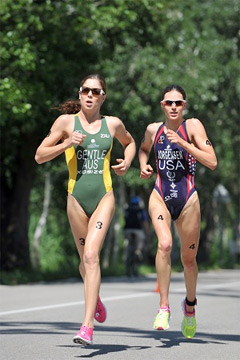 According
to the International Triathlon Union, and USA Triathlon, the Sprint Distance is
750 meter (.465 mi) swim, 20 kilometer (12.5 mi) bike, 5 kilometer (3.1 mi) run. According
to the International Triathlon Union, and USA Triathlon, the Sprint Distance is
750 meter (.465 mi) swim, 20 kilometer (12.5 mi) bike, 5 kilometer (3.1 mi) run.
A sprint triathlon is a short-distance triathlon, ideal for those competitors
who are new to the sport. Because the contests require less training and
experience, sprint triathlons are very popular types of endurance competitions.
Triathlons used to be the domain of elite athletes. But now more than 1 million
people stepped up to a triathlon starting line last year�37 percent of them
women, according to USA Triathlon. "Triathlons have taken over the reins from
marathons as the new personal challenge," says Barrie Shepley, Canada's former
Olympic and National Triathlon Team coach.
The swim-bike-run combo combats workout boredom and practically guarantees
weight loss. Plus, the popular sprint distance (half-mile swim, 12-mile bike,
and 3.1-mile run) eliminates intimidation. It gives a feeling of accomplishment
coupled with body-sculpting effects and can be addictive.
A triathlon is a physical competition involving three disciplines: swimming,
cycling and running. These three events are completed in succession without
breaks. Triathlons are endurance activities covering long distances.
The first modern triathlon took place at Mission Bay, San Diego, California on
September 25, 1974. Since then, triathlons have become extremely popular, and
are now held throughout the world. The most famous triathlon is the Hawaiian
Ironman. This contest is an annual event, and was the first long-distance
triathlon. It consists of a 2.4-mile swim, a 112-mile bike ride and a 26.2-mile
run.
Sprint triathlons are short-distance triathlons, usually consisting of a
750-meter swim, 20k-bike ride and a 5k-run. This is half the distance of an
Olympic triathlon and less than a quarter of the distance of the Ironman.
Distances may vary slightly from event to event, but they typically adhere to
the above standards. Because of their shorter distances, sprint triathlons have
become increasingly popular and are ideal for beginner or novice athletes.
Most sprint triathlons will ask competitors to arrive early to the event. Here,
athletes will check-in and receive their individual race number. Then they will
set up their transition area, a designated area along the route where racers
will store their bikes, sneakers and any other equipment needed for the next
stage of the race. In smaller events, athletes will all start the race together.
However, in most races, athletes are usually divided into professional and
amateur groups. Amateurs may then be further separated into groups based on age
or sex.
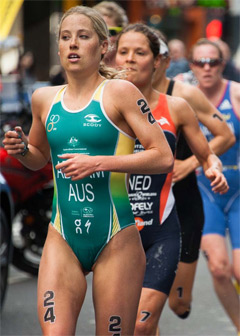 Triathlons start with the swimming portion of the race. Starts will either be
mass starts, where all the members of the separated groups begin together, or
wave starts, where smaller groups will begin every few minutes. The swimming
portion of the race will usually be done in open water. Therefore, most
participants will wear wetsuits. When completed, athletes will exit the water
and head to the transition area. The bike stage follows a pre-marked course, and
usually finishes where it began, near the transition area. Finally, the running
stage is also along a marked course that ends at the finish line. Triathlons start with the swimming portion of the race. Starts will either be
mass starts, where all the members of the separated groups begin together, or
wave starts, where smaller groups will begin every few minutes. The swimming
portion of the race will usually be done in open water. Therefore, most
participants will wear wetsuits. When completed, athletes will exit the water
and head to the transition area. The bike stage follows a pre-marked course, and
usually finishes where it began, near the transition area. Finally, the running
stage is also along a marked course that ends at the finish line.
Competing in a triathlon is a physically demanding task. Even training for a
short-distance triathlon, such as a sprint, can take several weeks or months of
training, depending on your physical fitness level. Because sprint triathlons
are endurance sports, the most important part of training is improving your
endurance with cardiovascular exercise. It's impossible to compete in a
triathlon without cardiovascular capabilities. Aside from the cardio aspect,
developing muscle is also a key component to the training regime. Because
triathlons are multi-disciplinary activities, and each discipline involves the
use of different muscles, developing muscle throughout the body is very
important.
Watch any triathlon and you'll see lean legs, flat abs, and sculpted arms
whizzing by�all thanks to the one-two punch of endurance and resistance
exercise. "Conditioning your body to plug away at three back-to-back disciplines
builds muscle endurance," says Lesley Mettler, a triathlon coach in Seattle.
"The resistance comes from pushing yourself through water, which is thicker than
air, and cycling up hills or into wind. Triathlon training is very balanced�it's
whole-body training."
And it shows. When you focus exclusively on one sport, you often end up strong
in some areas and soft in others. Triathletes get body benefits from all three
sports and are lean and fit from head to toe, says exercise physiologist Shannon
Grady, owner of Go! Athletics. Plus, the constant cardio can result in serious
weight loss.
But all that cardiovascular action is good for more than just dropping a few
pounds: A recent study in Radiology found that triathletes have larger,
healthier hearts and a 17 percent lower heart rate (fewer beats means your
ticker is so strong it doesn't have to work as hard) than other athletes.
Your joints, tendons, and muscles will thank you too. "Overuse injuries like
tendinitis and stress fractures often result from weakness elsewhere in the
body," explains Jordan Metzl, M.D., a sports medicine specialist at the Hospital
for Special Surgery in New York City and an eight-time Ironman finisher.
"Because of the amount of cross-training, triathletes build stronger muscles
around all of their joints, which reduces their injury risk," he says. "Think of
it as building scaffolding around a building."
A stronger body and better health starts with this step-by-stroke-by-pedal plan.
Swiming
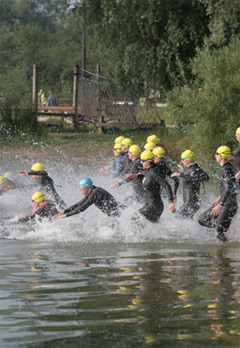 There's a reason even fit women end up hanging onto the side of the pool when
they first start doing laps. "In swimming, you use every single one of your
muscles to stay afloat and work through the tension of the water," says Pete
McCall, exercise physiologist with the American Council on Exercise. "And since
those muscles need oxygen and fuel, your body is asked to work harder." There's a reason even fit women end up hanging onto the side of the pool when
they first start doing laps. "In swimming, you use every single one of your
muscles to stay afloat and work through the tension of the water," says Pete
McCall, exercise physiologist with the American Council on Exercise. "And since
those muscles need oxygen and fuel, your body is asked to work harder."
But have no fear! Once you get your feet (and the rest of you) wet, you'll build
endurance fast and quickly learn to love this soothing, no-impact workout that
burns more than 500 calories an hour.
Breathe. "It's the single most important thing to master in swimming," says
Shepley. A steady inhale/exhale rhythm keeps you relaxed (like in yoga) while
increasing your speed and eliminating the need to gasp for air every couple of
strokes. Breathe out of your nose while your face is in the water and, on every
other stroke, tilt your head to the side, halfway out of the water, and take in
oxygen.
Once you're comfortable with that, breathe in on every third stroke to practice
getting air on both sides�a handy skill in open water since waves may break on
your favored side.
Roll with it. Rotate your shoulders, torso, and hips with each stroke to help
you glide through the water. "If you rotate your body from side to side�rather
than swimming flat�you'll move like a torpedo," says Shepley. In other words,
fast as hell.
Kick sparingly. Save your legs for the bike and run, and rely mostly on your
arms to pull you through the water. This prevents lactic acid from building up
in your legs, which in turn keeps your legs from tiring so they're ready when
you really need them. During training, squeeze a pool buoy between your legs as
you swim to practice using your upper body.
At first, aim to swim 250 meters once or twice a week. If you're sucking wind
(or water), break it into intervals of 25 meters (usually one length of a pool)
of nonstop swimming with 20 seconds of rest in between to catch your breath.
During the final month, make one session each week an open-water swim, if
possible, and practice sighting by looking up every six to eight strokes to
confirm you're on course.
Start each workout with 10 to 15 minutes of the following warmup drills. These
three exercises from Shepley will refine your stroke and help you generate more
power so you can learn to glide through the water effortlessly.
Catch-up drill (for stroke timing): Swim freestyle as usual, but leave one hand
in front until your other hand finishes the stroke and comes around to "tag" it.
Side-swim drill (for body position): Hold your left hand in front of you, palm
down. Swim with your left side, eyes looking at the bottom of the pool and right
hand glued to your right thigh for six kicks. Stroke with your left hand,
rotate, and switch sides. Repeat.
Fingertip drag (for arm position): As each hand ends its stroke, keep your elbow
high and carefully drag your fingertips along the surface as you bring your arm
forward.
Biking
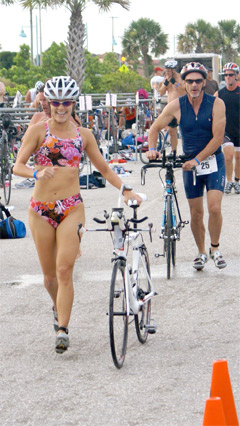 Triathletes consider the relatively "easy" cycling leg child's play�after all,
most people learned to ride when they were missing their two front teeth. And
while the skill of bike riding does come right back, there are a few training
tricks that will help you build lean muscle and pump the pedals on race day.
With proper prep, those 12 miles will fly by faster than you think. Triathletes consider the relatively "easy" cycling leg child's play�after all,
most people learned to ride when they were missing their two front teeth. And
while the skill of bike riding does come right back, there are a few training
tricks that will help you build lean muscle and pump the pedals on race day.
With proper prep, those 12 miles will fly by faster than you think.
Spin your wheels.Your bike is powered by your legs and core, which means your
upper body should be relaxed and motionless as your lower half does the work.
Try not to hold tension up top.
Shift. "Most beginners fall in love with one gear and don't shift as often as
they should," says Jonathan Cane, head coach for City Coach Multisport in New
York City. You want less resistance while going uphill, so shift down into a
lower gear (your legs will spin faster and with less effort) to help you over a
climb. Do the same whenever you come to a complete stop�starting again will feel
10 times easier in a low gear.
On flat or downhill terrain, shift up to a harder gear to add resistance so
you're not just coasting but powering through.
Pedal evenly. A good pedal stroke should be about pulling as much as pushing�a
complete circle of power and efficiency. And the smoothness will help your
entire form: "If you have a perfectly round pedal stroke, you'll notice your
hips, shoulders, and torso are stationary," says Cane.
If the last bike you rode was pink and had a basket on the front, start by
taking a spin class or riding a stationary bike at your gym for 30 minutes. Do
that two or three times a week to remind your muscles how to pedal before
hitting the road. Once you're used to the gym bike, hop on a road bike twice a
week for 30 minutes (to start). Just don't forget to vary your
terrain�especially if you're prepping for a hilly racecourse.
Running
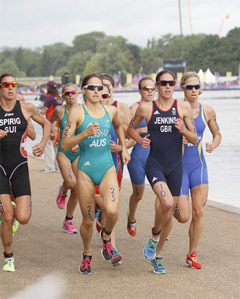 Because running is the last leg of the race, your training goal is to build
muscle endurance so you'll be able to finish strong when you're spent from
swimming and biking. "Since you have to bang out only a few miles on race day,
your running training focuses on boosting your body's VO2 max, or its efficiency
in using oxygen, to get you through all three legs," says McCall. "And the best
way to do that is by running shorter distances at higher intensities. In other
words, intervals." Because running is the last leg of the race, your training goal is to build
muscle endurance so you'll be able to finish strong when you're spent from
swimming and biking. "Since you have to bang out only a few miles on race day,
your running training focuses on boosting your body's VO2 max, or its efficiency
in using oxygen, to get you through all three legs," says McCall. "And the best
way to do that is by running shorter distances at higher intensities. In other
words, intervals."
Shorten your stride. Reducing your stride lessens the impact on your body, which
cuts your injury risk and also keeps your feet happy because they're spending
less time on the ground. Count the number of steps you take per minute and aim
for 180 (or three steps per second) as your goal.
Run relaxed. Bend your elbows to form 90-degree angles and make sure your fists
aren't clenched. Keep your jaw loose and your shoulders down. During easy runs,
you should be able to carry on a conversation. If you can't, slow down.
Start the first month with 20-minute runs twice a week, increasing time or
distance by no more than 10 percent each week. Smacks of slacking off? You're
really not: Thanks to your bike and swim cardio, 20 minutes is all you need
right now to stay fit, says Shepley. Adding two-minute speed intervals will
strengthen your legs and build the power you'll need to finish strong on race
day.
Before you dash, warm up your running muscles with the three plyometrics moves
below. Do each one for 10 to 15 steps, rest for 30 seconds, and repeat once.
Walking lunges: Step forward with your right foot and lower your body until both
knees are bent 90 degrees, keeping your right knee behind your toes. Push off
your front foot and switch legs, moving forward.
Butt kicks: Run forward, kicking your feet directly behind your body so that
your heels touch your butt.
Bounding: Run with an exaggerated stride length, lifting your front knee high
with each bound.
A good resource to find Sprint Triathlon near you in USA is
http://www.trifind.com/ and in UK at
http://www.britishtriathlon.org/
Video
Dated 18 January 2014
|
|
|
|
|
|
|









